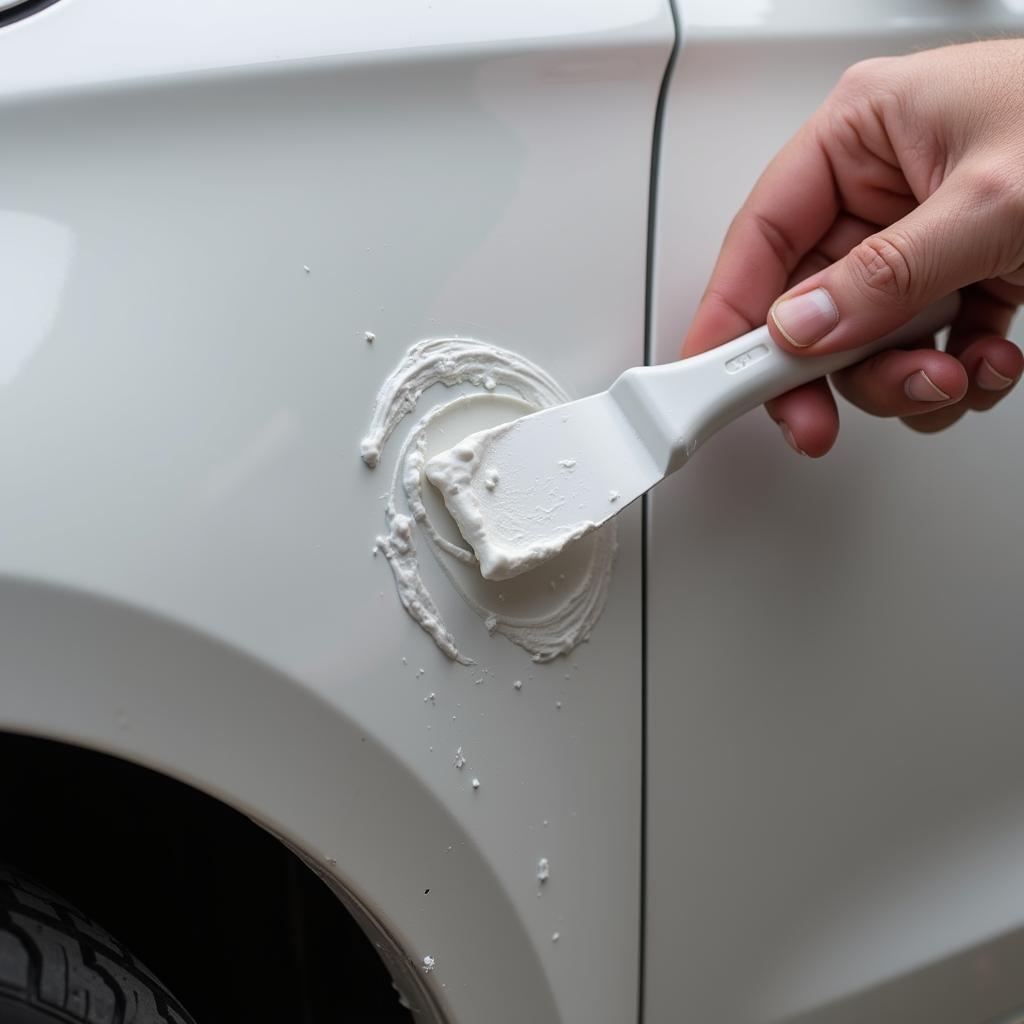
Applying Bondo to a Car Dent
Bondo Car Body Repair is a common practice in auto body work, used to fill dents, smooth surfaces, and repair minor damage. This guide will delve into the intricacies of using Bondo, exploring its applications, best practices, and common mistakes to avoid.  Applying Bondo to a Car Dent
Applying Bondo to a Car Dent
Understanding Bondo and Its Uses
Bondo, a brand name synonymous with body filler, is a two-part polyester resin often used in car body repair. It’s a versatile material capable of filling dents, repairing rust holes, and smoothing out imperfections. 'tools for car body repair. However, it’s essential to understand that Bondo isn’t a magic fix-all. It’s not meant to be a structural repair solution, and its effectiveness depends heavily on proper preparation and application.
When to Use Bondo
Bondo is best suited for cosmetic repairs on non-structural areas of the car body. Think minor dents, dings, and small rust spots. Using it on larger areas or structural components can compromise the integrity of the repair.
When Not to Use Bondo
Avoid using Bondo on large rust holes, significant structural damage, or areas subject to high stress. In these cases, welding or replacing the damaged panel is often the safer and more effective solution. For specific repair kits, visit our page about car body panel repair kit.
Preparing the Surface for Bondo Application
Proper surface preparation is crucial for successful Bondo application. This involves cleaning the area, removing rust, and creating a rough surface for the Bondo to adhere to.
Cleaning and Rust Removal
Thoroughly clean the area with soap and water, removing any dirt, grease, or wax. If rust is present, use a wire brush or sandpaper to remove it completely.
Creating a Rough Surface
Use coarse grit sandpaper to create a rough surface for the Bondo to grip. This helps ensure a strong bond and prevents the filler from cracking or peeling later. You can find all the necessary supplies at our car bodywork repair supplies page.
Applying Bondo Like a Pro
Mixing and applying Bondo requires precision and attention to detail. Follow these steps for optimal results:
- Mix the Bondo: Combine the resin and hardener according to the manufacturer’s instructions.
- Apply Thin Coats: Apply the Bondo in thin, even coats, working quickly as it begins to harden.
- Allow to Cure: Let each coat cure completely before applying the next.
- Sand and Shape: Once cured, sand the Bondo to shape, starting with coarse grit and gradually moving to finer grits.
Common Mistakes to Avoid
- Applying Bondo to bare metal: Always prime bare metal before applying Bondo to prevent rust and ensure proper adhesion.
- Using too much hardener: Excess hardener can cause the Bondo to cure too quickly, making it difficult to work with.
- Not sanding properly: Improper sanding can lead to an uneven surface and a poor finish. Consider getting professional car body repair tools for the best results.
“The key to a successful Bondo repair is patience and attention to detail. Don’t rush the process, and always follow the manufacturer’s instructions.” – John Smith, Automotive Repair Specialist
Conclusion
Bondo car body repair, when done correctly, can effectively repair minor damage and restore your car’s appearance. By understanding the proper techniques and avoiding common mistakes, you can achieve professional-looking results. For more specific information on Bondo repairs, visit our dedicated page on car body repair bondo.
FAQs
- How long does Bondo take to cure?
- Can I use Bondo on plastic bumpers?
- What type of sandpaper should I use for sanding Bondo?
- How thick can I apply Bondo?
- Can I paint over Bondo?
- How do I prevent Bondo from cracking?
- What are the alternatives to Bondo?
For any questions or assistance, please contact us via WhatsApp: +1(641)206-8880, or Email: [email protected]. Our customer service team is available 24/7.
